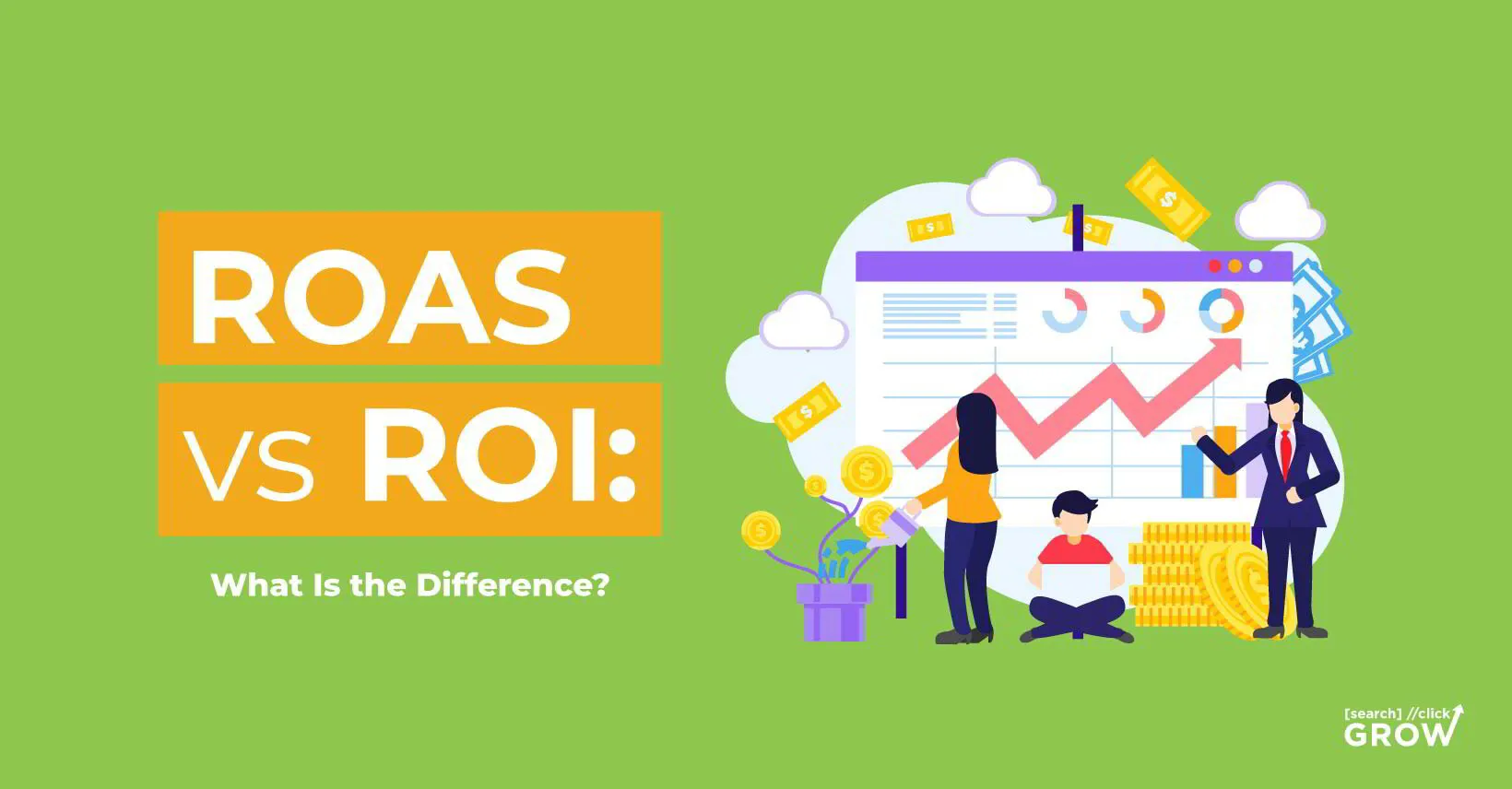For as long as I can remember being in marketing and business, the buzz word “ROI” was a continuous mantra, and despite the way some people used the acronym, it was not a self-fulfilling prophecy no matter how many times an executive said “guaranteed ROI”.
In contrast, return on advertising spend (ROAS) has become the preferred metric for showing the exact return on marketing investment, such as a budget applied to a Facebook campaign.
If your ROAS is high, you’re likely above a 5:1 ROAS, which means your campaign is earning you $5 in profit for every $1 you spend on advertising.
If you struggle to show how your campaign is bringing in revenue, then you likely haven’t mastered measuring ROI or ROAS.
We’ll show you what is ROAS vs ROI and what each of these metrics means to your business, how to calculate these metrics, and when’s the best time to use these as key performance indicators (KPIs).
ROAS vs ROI: What Is the Difference?
Both of these terms measure your investment, but ROAS is specific to measuring marketing and advertising dollars.
In recent years, digital advertisers rely on ROAS to measure the success of their online campaigns. When a campaign has a high ROAS, it’s said to be “making money hand over fist”.
Here’s how to tell the difference between ROAS vs ROI:
What is ROAS?
ROAS is a ratio that shows the average profitability of a single campaign or all of your marketing and advertising at once.
The ratio is typically shown as a 1:1 where you’re breaking even if you’re making one dollar for every dollar you spend.
How to Calculate ROAS
To calculate ROAS, you just need to know your total revenue and expenses per campaign.
Revenue/Expenses
ROAS is an equation that divides revenue by expenses.
For example, you run a Facebook campaign with a total budget of $5,000. The campaign has 200 conversions equalling $15,000 in revenue.
- ROAS = Revenue/Expenses
- $15,000/$5000 = $3 for $1 marketing dollar spent or 300% return
- To report on ROAS as a percentage, you simply use the formula (Revenue/Expenses) x 100 = ROAS
This campaign has a 3:1 ROAS, meaning that every time you spent a dollar on the campaign, it earned you $3. You can also report on this metric in a percentage of 300% ROAS.
Editor’s Note: Use our FREE Advertising ROAS Calculator to help you project your advertising campaign before you start investing so you know your advertising ROAS before you begin.
See the difference yet between ROAS vs ROI?
There is a flaw in ROAS because it only reflects the return on advertising spend.
While this formula is relatively simple for a single campaign, it doesn’t factor in some of the other costs, such as retaining a designer and developer to create the materials for the campaign.
That’s just the basic additional costs.
What about the salesperson’s payroll hours trying to work that conversion or the actual production cost of making the product featured in the campaign?
Those are considered investment costs.
If you factor in those additional costs, you are actually looking at the total ROI instead of just advertising spend.
It’s important to recognize this investment into creative and development as new clients will look at recouping their entire costs, not just the budget for a campaign.
Pros of ROAS
- Metric that shows campaign success or failure
- Identifies channel-based silos wasting marketing dollars
- Easy to calculate and report on
- Best to include alongside conversion cost and conversion rate
Cons of ROAS
- Does not reflect total investment cost (creative design, development, landing page hosting, sales, payroll hours, etc)
- Doesn’t work when looking at total marketing and advertising success
What Is an Acceptable ROAS?
For some companies, it's important to just break even, but most companies want to make more than double their money back on advertising, especially if they have higher operating costs. It's also relative to the business health and individual profit margins.
There are some companies that struggle even when campaigns have a 10:1 ROAS, simply because their operating costs are too high or the business health has gone down the toilet.
A common goal for most businesses should be a 5:1 ROAS or a 500% return on advertising cost. This means that your campaign is not only effective, but you'll make a decent profit.
There are some costs that you should also calculate into your advertising spend beyond just the budget that you set for the campaign.
For example, your Facebook campaign budget is $5,000, but you also spent money on vendor and partner costs who are working with you on the campaign.
When to Use ROAS
You should use ROAS when measuring the effectiveness of your digital marketing and advertising campaigns
ROAS measures a simple cost, not an entire investment. When you want to measure and compare your digital marketing campaigns, ROAS can tell you exactly what campaigns are spending and not delivering any return.
It’s helpful for identifying your best campaigns for marketing investment while eliminating or showing areas of improvement for underperforming campaigns.
If using audience targeting and segmentation, you can use ROAS vs ROI to break down return by the audience, thus showing what customers are more likely to interact and purchase from you in the future.
Measuring Social Media & Other Channel Silos
ROAS is particularly effective when trying to measure return by channel, too.
If your company is spending X amount of dollars on Facebook, Instagram, Google, and Pinterest campaigns, you can break each of these down by ROAS.
However, this goes a step beyond just measuring your advertising campaigns. If you spend money on the development, creative, management, and hosting of your site's blog, amounting to $1,500 a month, but that blog does not have any clicks, impressions, or conversion possibilities, you're going to eat that cost every month.
You could simply change this by adding CTAs to your posts and an email opt-in form to your blog. There's also affiliate marketing and product linking that could bring in revenue.
Ideally, every channel where you publish content, mobile ads, or other marketing creatives is earning some kind of revenue or supporting revenue in some way for your business.
The ROAS is the closest formula for measuring how successful each of these channels is at generating a return for your business, even if they're not expected to do so.
However, much of advertising has bigger costs, so ROAS isn't always an entirely accurate "big picture view" of a company's health.
When you want to know if your total investment is profitable, you should use ROI.
What is ROI?
Whereas ROAS is the ratio of revenue to expenses, ROI is the ratio of net profit to investment. This metric helps you measure the return on any specific investment, relative to the total cost of that investment.
This is a more accurate representation of what you’re getting back (return) from any investment, which may include the following:
- Personnel
- Software
- Hosting
How to Calculate ROI
To calculate ROI, you’ll simply use the following formula:
- ROI = (Net Profit/Net Spend) x 100
In comparison, the ROAS was 300%, which is a much higher return for one campaign.
When your ROI is lower than ROAS, it typically means that your campaigns are effective but the total project needs some help.
You may be spending too much on unnecessary software or personnel.
Things to Consider with ROI
ROI can also measure the return on engagement, brand awareness, clicks, impressions, and so forth.
While we focus primarily on monetary return with any campaign, you should also look at metrics revealing what campaigns have positive engagement, as it leads to higher brand visibility and hopefully long-term customer value.
If a company is investing thousands of dollars into marketing, it's important to show ROAS and ROI by the numbers, but also for brand KPIs.
Here are some other metrics to look at:
- Total new customers
- Customer retention rate
- Social media shares
- Follower rate (particular to social media campaigns)
- Leads generated per campaign
- Conversions and conversion rate
- Reputation score
- Average order value
- Total impressions
- Total clicks
- Cost per click
- Likes
- Comments
These important KPIs give an even more detailed picture of what channels are ROI leaders, and which ones do nothing for your brand.
You may be able to spot areas where you haven't served the audience consistently or may not be utilizing buyer personas as effectively as with other channels.
When to Use ROI
It’s important to note that this is immediate ROI, whereas most ROI should consider projections for the next quarter and beyond.
If the campaign continues successfully at 300% ROAS, you’ll eventually have higher and higher returns.
ROI is a helpful metric when you want to know whether your company is at a loss and what you need to do to fix that.
Many companies throw money into marketing without realizing the total cost of investment, so even if a campaign is successful, they may only break even because the marketing cost was so high.
ROAS vs ROI? What should you use?
The truth is that you need both metrics to identify where your losses are coming from and how to mitigate those losses, as well as what is working and how to capitalize on that success even more.
Without ROAS, you really don’t know what marketing dollars are generating revenue for your company, but without knowing your true ROI, you don’t know where you stand overall.
However, it’s never a good time to measure ROI at the start of a campaign to show success rates unless it’s exceptionally high.
Marketing campaigns generally need a 30-day window to show initial return, and after tests and tweaks are made, ROI should have a considerable lift, resulting in a more accurate projection for the following quarter.
How Do You Measure Your Marketing?
If you haven’t seen a return on your marketing yet, you may just need some small tweaks to your creative, but you’ll never know until you can look at actual metrics and key performance indicators.
Schedule a chat with us and we will help you identify the EXACT steps you should be taking to reach your goals.


